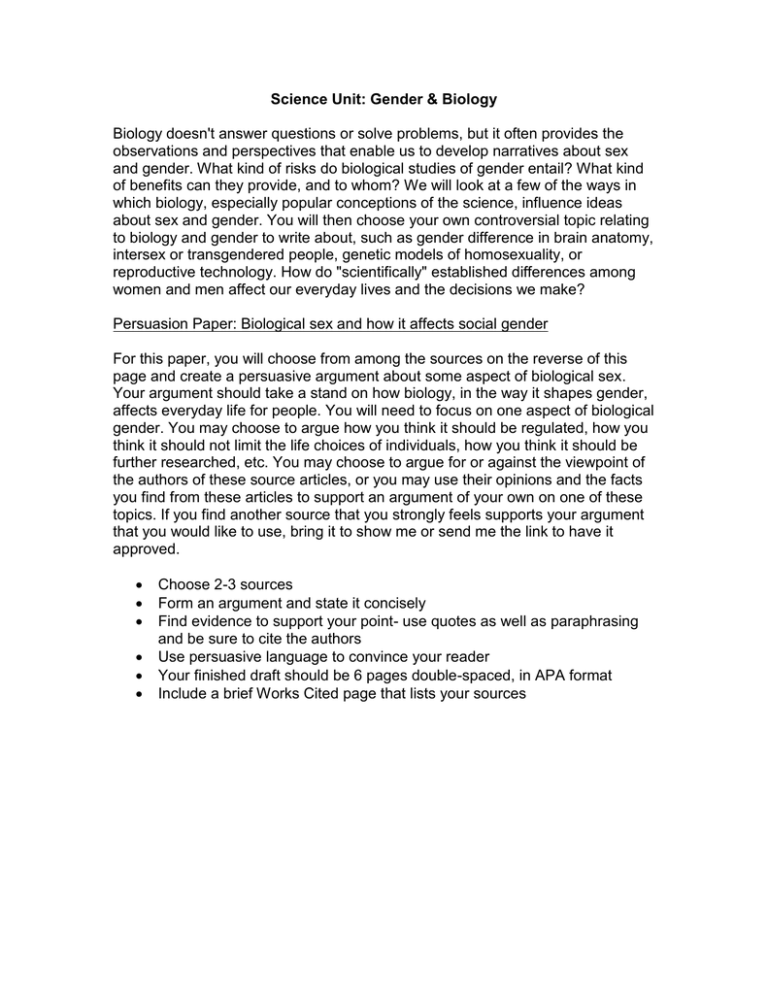
Science Unit: Gender & Biology
Biology doesn't answer questions or solve problems, but it often provides the
observations and perspectives that enable us to develop narratives about sex
and gender. What kind of risks do biological studies of gender entail? What kind
of benefits can they provide, and to whom? We will look at a few of the ways in
which biology, especially popular conceptions of the science, influence ideas
about sex and gender. You will then choose your own controversial topic relating
to biology and gender to write about, such as gender difference in brain anatomy,
intersex or transgendered people, genetic models of homosexuality, or
reproductive technology. How do "scientifically" established differences among
women and men affect our everyday lives and the decisions we make?
Persuasion Paper: Biological sex and how it affects social gender
For this paper, you will choose from among the sources on the reverse of this
page and create a persuasive argument about some aspect of biological sex.
Your argument should take a stand on how biology, in the way it shapes gender,
affects everyday life for people. You will need to focus on one aspect of biological
gender. You may choose to argue how you think it should be regulated, how you
think it should not limit the life choices of individuals, how you think it should be
further researched, etc. You may choose to argue for or against the viewpoint of
the authors of these source articles, or you may use their opinions and the facts
you find from these articles to support an argument of your own on one of these
topics. If you find another source that you strongly feels supports your argument
that you would like to use, bring it to show me or send me the link to have it
approved.
Choose 2-3 sources
Form an argument and state it concisely
Find evidence to support your point- use quotes as well as paraphrasing
and be sure to cite the authors
Use persuasive language to convince your reader
Your finished draft should be 6 pages double-spaced, in APA format
Include a brief Works Cited page that lists your sources
SOURCES:
Angier, Natalie. “Darwinians look at rape, sex, and war.” American Scientist 88.
Bailey, J. Michael and Richard C. Pillard, "A Genetic Study of Male Sexual
Orientation," Archives of General Psychiatry 48 (1991): 1089-96.
Hamer, Dean H. et al., "A Linkage between DNA Markers on the X Chromosome
and Male Sexual Orientation," Science 261 (1993): 321-27.
Hamer, Dean H. et al, “A Candidate Gene Study of CYP19 (Aromatase) and
Male Sexual Orientation.” (2004) (UC elinks)
Koyama, Emi. “The Transfeminist Manifesto.” (electronic reserves)
LeVay, Simon. "A Difference in Hypothalamic Structure between Heterosexual
and Homosexual Men," Science 253 (1991): 1034-37.
Murphy, Timothy F. “The Search for the Gay Gene.” (PubMed)
Rubin, Jeffrey Z., Frank J. Provenzano, and Zella Luria “The Eye of the Beholder:
Parents' View on Sex of Newborns.” (WATW 568-576)
Switzer, Latesha. “Can Surgery for Intersex Babies be Justified?”
www.york.cuny.edu
Wikan, Uni. “The Xanith: A Third Gender Role.” (WATW 595-606)
“Extreme skewing of X chromosome inactivation in mothers of homosexual men.”
Human Genetics 118(6) (2006): 691-4.
www.intersexinitiative.org
University of Michigan Multidisciplinary Pediatric Intersex Clinic
